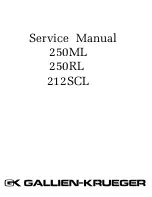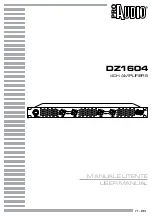
18
The Hartke Kilo Bass Amplifier gives you enormous control over shaping the sound
of your bass, using a process called equalization. To understand how this works, it’s
important to know that every naturally occurring sound consists of a broad range of
pitches (frequencies) combined together in a unique way. This blend is what gives
every sound its distinctive tonal color.
The first section of the Kilo’s EQ controls is a three-band tube tone
stack equalizer. The tone stack EQ is a fixed bandwidth EQ, with no
frequency control. It is a little different than normal boost and cut
hi-fi bass and treble controls as there is no theoretical “flat” setting. When the three
knobs (labeled BASS, MID, and TREBLE) are at their center (12 o’clock) position, the
response is set to a preset equalization curve that has been tailored for the bass guitar.
The BASS and MID controls are somewhat interactive, so as you raise and lower the
MID knob, the center frequency of the BASS control will shift. The TREBLE control is
arranged to be independent from the BASS and MID controls, so that you can raise the
high frequencies without affecting the low end. You should experiment with the EQ
knobs and your particular bass to dial up the best sound.
In addition to the three EQ controls, the Kilo also includes BRITE
and DEEP switches. The BRITE switch adds an overall boost to the
high-end frequency response. This button works in conjunction
with the GAIN knob (similar to the Loudness button on a stereo).
As you raise the GAIN, the overall boost is diminished. When the GAIN is set to “10”
(turned fully clockwise), the BRITE switch has no effect on the audio. The DEEP switch
shifts the position of the low frequency and mid scoop to enhance the low end (“boo-
ty”) of the bass guitar. The SHAPE switch and knob apply an adjustable notch (scoop)
filter to the specified frequency area, so that you can customize the effect of the EQ
curve that best complements your particular bass instrument. Moving the SHAPE con-
trol clockwise causes the notch filter to be applied to higher frequencies, while moving
the knob counterclockwise causes it to be applied to lower frequencies.
The ten-band constant-q graphic equalizer provides ten
sliders, each corresponding to a single narrow frequency
band. This allows you to “draw” the desired tonal response
from your system. When a slider is in its center (detent)
position (“0”), it is having no effect. When it is moved
above center (towards “+12”), the particular frequency
area is being boosted. When it is moved below center (towards “-12”), the frequency
area is being attenuated. Normally, you will adjust the three-band EQ controls before
“fine-tuning” your EQ with the graphic equalizer.
In many instances, the best way to deal with equalization is to think in terms of which
frequency areas you need to attenuate, as opposed to which ones you need to boost.
Be aware that boosting a frequency area also have the effect of boosting the overall
signal; specifically, too much low frequency EQ boost can actually cause overload
distortion, or even harm a connected speaker. In general, if you’re going to apply a fair
amount of low frequency EQ boost, it’s a good idea to keep compression on, if only to
protect your speakers from potential damage.
About Equalization







































